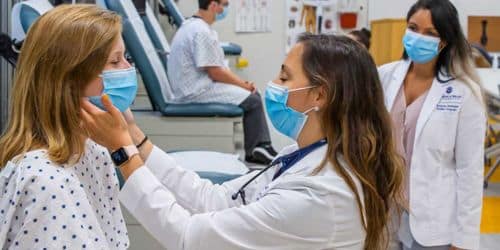A physician assistant (PA) is a qualified healthcare worker who supports medical practitioners in patient care while working under their supervision. If you want to work in the medical industry but don’t want to attend medical school, a job as a physician assistant can be of interest to you. This article explains the job description, salary and the prerequisites of a physcian assistant. We also explained the difference between a physician assistant vs a nurse practitioner. So, let’s dive in!
Who Is a Physician Assistant?
In the medical field, a physician assistant (PA) or physician associate (PA) assists doctors in the assessment, diagnosis, and treatment of patients. When a physician assistant is helping a patient, the doctor does not necessarily need to be there.
The responsibilities of a physician assistant include:
- Taking detailed patient histories and conducting in-depth physical examinations
- Collaborating with other members of the healthcare team to formulate an effective treatment strategy
- Identifying unusual discoveries and acting quickly on the detection of medical or mental health problems
- Making diagnoses based on test results, including blood work, urine analysis, and imaging studies.
- Medication Administration and therapeutic strategy
- Informing patients of their diagnoses, how to take care of themselves, and how to avoid getting sick
- Fixing broken bones and sewing up cuts are examples of such minor surgical procedures.
- Serving as an aid to surgeons during more involved operations
- Keeping detailed records and notes on each patient.
What Does a Physician Assistant Do?
Physician assistants (PAs) provide medical care to patients in a wide range of venues, from hospitals and clinics to schools and private practices. Although PAs work under the supervision of a physician and in concert with other medical professionals, many of them also exercise considerable autonomy in their practices. Documenting patient histories, making diagnoses, creating treatment plans, and writing prescriptions are all potential daily tasks for a physician’s assistant.
Physician Assistant Job Description
There is a wide variety of work that can be done by a physician assistant. The job descriptions a physician assistant is quite similar to that of doctors.
The precise job description of a Physician assistant range depending on the state in which they work and the particular hospital or clinic where they are employed. Here is the job description of a physician assistant:
- Gathering In-Depth Health Background Information
- Performing diagnostic procedures including blood tests and X-rays and analyzing the results
- Physiological testing and methods
- Making incisions and assisting with other surgical procedures
- Making the rounds in a hospital
- Making medical diagnoses
- Formulating patient treatment strategies
- Keeping an eye on how a patient is doing
- Conducting medical experiments
- Vaccination Administration
- Medication prescriptions
- Helping people out in their own homes
- Maintaining a patient health record
- Discussing patient cases with other doctors and nurses
- Treatment and preventative care counseling for patients and their families
How to Become a Physician Assistant
The following are the steps to take to become a physician assistant:
#1. Earn an Undergraduate Degree
A physician assistant must first complete a bachelor’s degree program. Although there is no required major, studying biology, health sciences, or pre-medicine will help you make the most of your degree. Sports science, genetics, and nursing are all viable options for certain students. Human biology, physiology, and anatomy are only some of the topics covered in a normal undergraduate health science course, along with medical ethics, mathematics, and research methods.
#2. Gain Practical Experience
Most Physician Assistant (PA) programs require applicants to have at least 2,000 hours of clinical experience or three years of work history in the medical field. Getting a bachelor’s degree in a healthcare field like nursing or paramedic science will help you locate a job that will provide you with the experience you need to become a nurse or paramedic. Becoming a certified nursing assistant, medical assistant, or registered nurse are some careers you can pursue to get expertise.
#3. Enroll in a PA Program
The Accreditation Review Commission on Education for the Physician Assistant (ARC-PA) recognizes master’s degree programs in the physician assistant field that can be completed in two years after earning a bachelor’s degree. The Physician Assistant Education Association can provide information about recognized PA schools that offer courses in anatomy, physiology, biology, pathology, pharmacology, prescription, law and ethics, biochemistry, genetics, statistics, and more.
Medical subspecialization is an area where physician assistant training might be extremely helpful. Candidates may have the chance to apply the concepts they learn in professional settings through the programs’ in-depth instruction.
#4. Pass the Physician Assistant National Certifying Exam
Once the PA program is complete, register for the PANCE, a five-hour exam that certifies physician assistants. There are 300 multiple-choice questions covering topics in medicine and surgery in the exam. The exam can be taken no more than six times within a six-year period. A Physician Assistant program can be re-enrolled in by anyone who fails to pass after six tries. Certified PAs can use the PA-C designation until their certification expires after completing the PANCE administered by the National Commission on Certification of Physician Assistants. The NCCA has granted NCCPA certification agency status.
#5. Obtain a License in Your State
Physician assistants must also obtain a license from the state in which they intend to work. Before submitting materials, make sure you are aware of your state’s specific criteria since they may differ from those in other states. The majority of the time, getting a license entails passing the PANCE exam and completing a set minimum of CME hours.
#6. Prepare a Resume and Cover Letter
Writing your CV and cover letter for applications to Physician assistant job postings is the next step. Give careful thought to each position you apply for, and tailor your CV accordingly. Don’t forget to highlight your relevant clinical experience, stellar exam results, awards, grants, and accomplishments in your resume.
What Skills Does a Physician Assistant Need?
The following are skills needed by a physician assistant:
#1. Feeling and Showing Compassion
Patients may be in pain and/or distress when they visit you because they are ill or weakened. It’s crucial to put yourself in their shoes, experience what they’re feeling, and empathize with them. This can put them at ease during treatments with you.
#2. Capacity for Attentive Listening
Listen carefully to the patient’s account of their health problems and symptoms in order to make a diagnosis. You can probe for specifics, and you have an excellent memory for the information you’ve been given.
#3. Competence in Analysis and Problem-Solving
Once you have a thorough understanding of the patient’s condition or sickness, you may utilize your analytical skills to develop a treatment plan based on the most recent medical research and effective remedies.
Physician Assistant Salary
The median annual salary for a physician assistant is $121,530, or $58.43 per hour, which is significantly higher than the average wage in the United States. However, the salary of a Physician assistant varies by location and practice scenario.
Physician Assistant Prerequisites
You must pass an entry-level PA curriculum that is ARC-PA recognized before you may work as a PA. Most PA schools expect their entrants to have at least a bachelor’s degree before they may enroll. Some PA schools, however, have a pre-professional period where high school seniors and students with some college credit can get a head start on the profession. Pre-professional phases of programs often last between two and four years, giving students time to focus on their undergraduate studies before moving on to more advanced topics. If a prospective PA student is interested in a program that includes a pre-professional phase, he or she should contact the relevant institution to learn more about the prerequisites and application procedures.
Most entry-level have the following physician assistant prerequisites:
- Anatomy
- Physiology
- Biochemistry
- Biology
- Microbiology
- Chemistry
- Organic Chemistry
- English Composition/Writing
- Genetics
- Medical Terminology
- Psychology (general)
- Statistics
Many PA programs also require prior healthcare experience with hands-on patient care.
Though it’s not an exhaustive list, you can get healthcare experience by being a:
- Medical assistant
- Emergency medical technician
- Paramedic
- A medic or medical corpsman
- Lab assistant/phlebotomist
- Registered nurse
- Emergency room technician
- Surgical tech
- Certified nursing assistant
Also, most students have about three years of healthcare experience before entering a program.
Physician Assistant vs Nurse Practitioner
It’s common for laypeople to use the terms “Physician assistant” and “nurse practitioner” interchangeably; after all, the two careers share many responsibilities, such as the ability to prescribe medications and treat injuries. However, there are important distinctions between a physician assistant vs a nurse practitioner.
The primary distinction is that PAs need to complete 2,000 hours of clinical rotations under supervision, while NPs only need 500-650. However, unlike PA programs, nurse practitioner master’s programs are often several months long and require a bachelor’s degree in nursing (BSN) and an RN license before to admission.
And while both a Physician Assistant vs a Nurse Practitioner have a broad medical education, NPs often choose to focus on a particular field of medicine, such as geriatrics, mental health, or family practice. PAs are considered generalists, however, they have the option to specialize later in their careers.
What Are the Benefits of Becoming a Physician Assistant?
There are many draws to the field of physician assistance, including good pay and the chance to provide direct treatment to patients in critical situations. There is a lot of job security and opportunities in this field. Furthermore, PAs have a great deal of room for development. While they receive a broad education in medicine, many opt to specialize in either surgery or palliative care instead. Within this framework, they can venture into uncharted territories. PAs can easily switch specialties due to their broad medical and surgical education. Each year, 7% of PAs switch specializations; in most cases, they don’t even need to get new certificates to do so.14
Getting more education and working in a lucrative field like radiology can help boost earnings. The desire to help those who need it most motivates some people to pursue careers as PAs. Physician assistants (PAs) are becoming increasingly important to the healthcare system in the United States due to their shown ability to reduce healthcare costs and boost physician productivity.
Where Can a Physician Assistant Work?
A physician assistant can work in the following places:
- Hospitals
- Physician offices
- Rural and urban community health centers
- Nursing homes
- Retail clinics
- Schools and university-based facilities
- Industrial settings
- Correctional institutions
- The uniformed services and other federal government agencies
Career Outlook for a Physician Assistant
The U.S. Bureau of Labor Statistics predicts a bright future for Physician Assistants, with an average annual growth rate of 31% from 2018 to 2028. Physician assistants can find work in any area of medicine, including general medicine, subspecialties of internal medicine (such as cardiology and endocrinology), surgery, orthopedics, women’s health, pediatrics, emergency medicine, and psychiatry. With doctors, surgeons, and other medical professionals on their teams, physician assistants practice medicine. According to the AAPA Salary Report 2019, the typical salary for a primary care physician assistant in the United States in 2019 was $100,000. This number increased to $110,000 in Connecticut.
Physician Assistant vs. Doctor of Medicine (MD)
There are significant distinctions between MDs and PAs. The educational and training foundations are where PAs and MDs diverge most sharply from one another. A doctor of medicine (MD) must complete four years of medical school and then spend an additional three to four years specializing in a field like pediatrics, orthopedics, or neurosurgery before they may receive their degree. For example, additional years of training are needed to become a subspecialist in pediatric cardiac surgery. Specialist doctors may spend ten years or more in medical school.
However, PAs must enroll in a full-time program that lasts for 27 months. It could take more time to complete a PA program online. When it comes to evaluating, diagnosing, and treating patients, a physician assistant (PA) is an invaluable resource. They are the first line of defense in the treatment of illness and can work independently or with a doctor. The Bureau of Labor Statistics predicts that, between 2018 and 2028, the PA profession would grow by 31%, which is substantially faster than the average for all occupations.
Is Being a Physician Assistant Harder than a Doctor?
Despite the fact that both PA and MD schools present their fair share of challenges, the MCAT, length of study, and rigor of most MD courses suggest that PA is not more challenging than medical school.
Is PA School More Competitive than NP?
Students preparing for careers in medicine don’t need to log 1,000 hours in direct patient care, but they do need to put in hundreds of hours in a variety of extracurricular activities, such as clinical work, research, volunteerism, and leadership. NP programs are the easiest to get into and have the fewest strict criteria.
Final Thoughts
A physician assistant is a highly trained medical professional that can treat patients in a wide range of specialties and environments. Clinical education for PAs is second only to that of MDs, and they receive extensive training in all areas of medicine. PAs are in high demand because of the wide variety of clinical settings in which they are permitted to work as a result of their extensive education and training. We do hope that this article was helpful.
Related Articles
- BUSINESS LICENSE PA: Definition, How To Get It, Cost & Guide
- WHAT DOCTOR MAKES THE MOST MONEY
- BEST JOBS IN THE WORLD 2023
- What Is the Performance Management Process? Building an Effective PM Process
- WHAT IS A POS: How It Works, Insurance & What You Should Know






